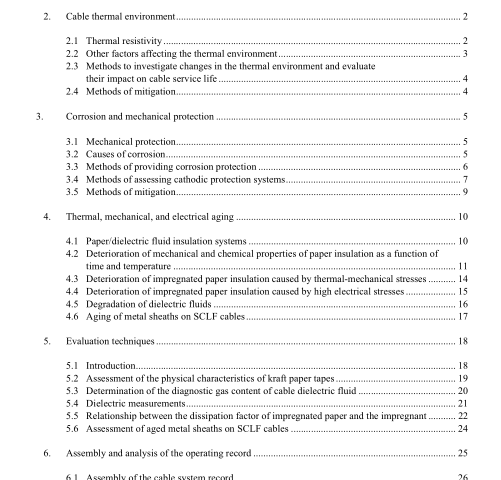IEEE 1478-2001 pdf download.IEEE Guide for the Evaluation of the Remaining Life of Impregnated Paper-Insulated Transmission Cable Systems
This guide provides technical information regarding factors that can affect the life of an impregnated paper- insulated transmission cable system, and it reviews available methods to evaluate the remaining life of such systems and preventive maintenance to extend their service life.
1.2 Purpose
This guide provides technical background, discussion, and advice to those needing to evaluate the remaining life of impregnated paper-insulated transmission cable systems. Guidance is given for both high-pressure fluid-filled (HPFF) (see Association of Edison Illuminating Companies CS2-97 [B12] 1 ) and self-contained liquid-filled (SCLF) (see Association of Edison Illuminating Companies CS4-93 [B13]) cables, which use a dielectric liquid as the filling and pressurizing medium (dielectric fluid), and for high-pressure gas-filled (HPGF) (see Association of Edison Illuminating Companies CS2-97 [B12]) cables, which use nitrogen gas as the filling and pressurizing medium.
The information presented here is intended to provide a complete and concise summary and overview, with frequent references to the technical literature for those who wish to investigate specific subjects in more detail. Emphasis is placed on practical, realistic, and economical methods for performing field and laboratory sampling and testing, and later analysis to determine the actual condition of a cable installation. This guide describes the various aging mechanisms that act on cable components. This includes aging of the outer protective coverings and the fluid-containing sheaths and pipes. It also includes thermal-mechanical aging of SCLF cable sheaths and their mechanical aging due to creep and fatigue, and thermal-mechanical aging of HPFF insulation due to flexural fatigue resulting from cyclic loads. Thermal and electric stress aging due to cable heating effects and the applied voltage are covered as well.
Methods are presented to assist in evaluating the extent of cable aging. Both intrusive and nonintrusive techniques are described; however, emphasis is placed on the latter. Treatment of the subject includes a description of traditional evaluation methods used in the past, supplemented by newer and emerging methods. Emerging methods include dissolved gas and metals analysis of dielectric fluids, as well as tests for other byproducts of the decomposition of cellulose, which can be used to gauge insulation aging and diagnose incipient failure mechanisms. Finally, advice is provided on preventive maintenance methods, for use in extending the actual service life of a cable system well beyond its economic life
It is intended that this guide be revised periodically to reflect new developments in diagnostic technology and experience gained with long service-operating cables.
1.3 Unit conversion factors and acronyms
Metric units are used. Unit conversion factors are given in Annex B.
All acronyms used are defined at their first use.
All technical terms are as per IEEE definitions.
2. Cable thermal environment
The cable operating temperature is a direct function of its loading and of the thermal resistivity of surrounding soils (see AIEE Committee Report [B4], Mochlinski [B71], and Schmill [B91]). Although a cable operated continuously or frequently at loads exceeding its design limits will overheat even if the cable thermal environment is unchanged, changes to the environment in which a cable is placed may result in the cable operating at temperatures exceeding design temperatures. Overheating accelerates cable aging (see Kurtz [B66]) or forces cable derating (see AIEE Committee Report [B4]).
For the purpose of this discussion, the cable thermal environment includes, in the case of land cables, the backfill in which it is embedded, the surrounding soil, the surface cover, the water table, and the proximity to external heat sources. In the case of submarine cables, the marine environment and sediments in which the cables are placed have to be considered.
The cable environment can change with time due to either natural or man-made processes. This clause discusses changes in the cable thermal environment and the methods that could be used to mitigate harmful influences on cable service life.IEEE 1478 pdf download.IEEE 1478-2001 pdf download
IEEE 1478-2001 pdf download

Leave a Reply